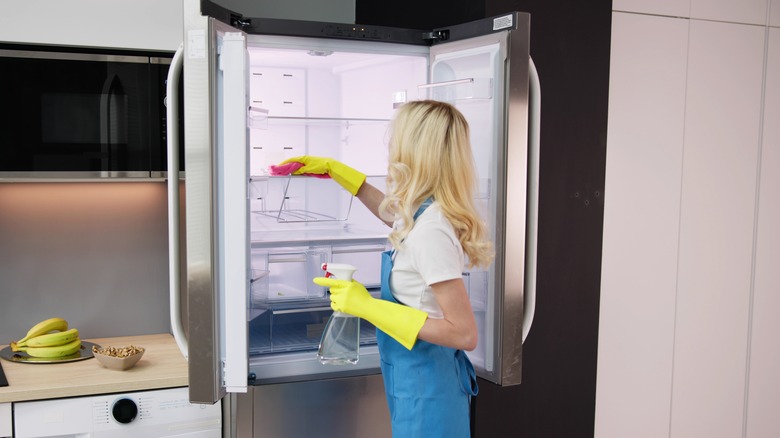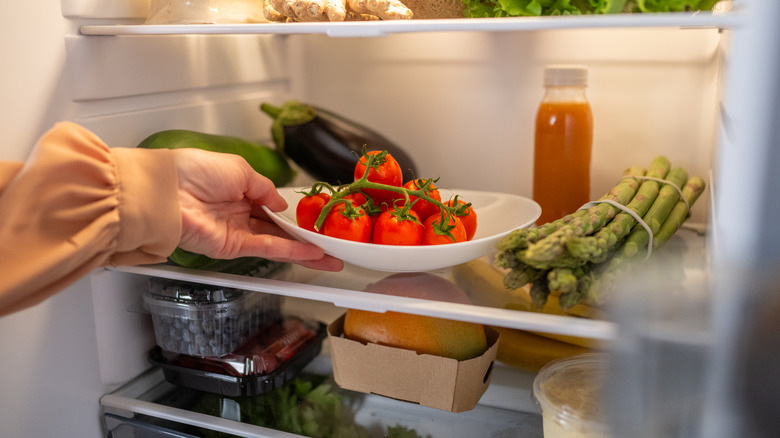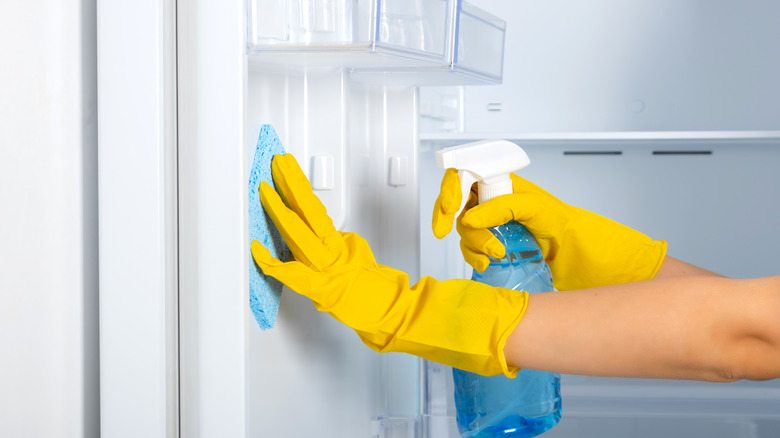Try This Easy Vinegar Hack For A Squeaky Clean Fridge
Does your fridge resemble a war zone more than a cooling appliance? If the answer is yes, you need to clean it before it starts grossing you out in earnest. Regularly deep cleaning your fridge — at least every quarter — will ensure the appliance functions without issues and improve the airflow inside to prevent your perishables from spoiling. However, avoid using chemical-based cleaners or popular cleaning agents like bleach, as they might harm the refrigerator's parts and give off toxins that can get absorbed by the stored food items. Instead, try this easy vinegar cleaning hack to make your refrigerator really sparkle.
All you have to do is combine vinegar with warm water to disinfect your fridge. Of all the kinds of vinegar out there, distilled white vinegar is ideal for cleaning because it easily eliminates grime and grease buildup from the dirty surfaces. Plus, given its mild acetic acid concentration (around 5%), you won't have to worry about it staining or corroding the insides of your fridge. But before you arm yourself with the cleaning solution, switch off the power button and unplug the fridge to prevent mishaps — you don't want to mix in electricity with liquid cleaning solutions.
Steps to take before deep cleaning your fridge
After you unplug the refrigerator, open the door and take out the food and drinks stored inside. As you remove them, check the "best before" date for each item and toss the expired ones in the trash. For items nearing their death sentence, make a mental note to place them in your direct line of sight and consume them before they go bad. Wipe the dirty jars and containers with a clean microfiber cloth prior to placing them on another surface. Regarding the perishables, like meat, and frozen food products, place them in your freezer (if you have a separate unit), a cooling unit, or make DIY coolers by filling Styrofoam boxes with ice.
Now, check if the detachable drawers and shelves have reached room temperature when taking them out for cleaning. This is important since taking them out when they're cool to the touch will lead to cracks in their plastic surfaces due to the difference in temperature. Once you take them out, fill your kitchen sink (or another big enough container) and leave them to soak in warm water for a while. This step is incredibly useful if the plastic surfaces are extremely dirty and sticky, and have stuck-on debris. Then, mix mild dish soap and water and use a sponge to give them a good scrub. Rinse the shelves and drawers well, and let them air dry (or wipe them dry) while you tackle the refrigerator's insides.
How to deep clean fridge with distilled white vinegar
Grab a spray bottle and fill it with equal parts distilled white vinegar and warm water. Shake it well and liberally spray the interior, including the non-detachable shelves and drawers, walls, and door. Let the solution work its magic for a few minutes (minimum 10 minutes) to loosen stubborn stains and gunk. Once the time is up, get a clean sponge and employ elbow grease to bring the insides to a shine. In case you're unable to reach any nooks or crannies, get an old (gentle-bristled) toothbrush to clean the appliance from head to toe.
After you're satisfied, dampen a microfiber cloth (or sponge) and use it to remove the cleaning solution from the interior. Work from top to bottom to avoid cleaning a surface twice. Rub it dry with a clean microfiber cloth before placing the cleaned shelves and drawers. But it isn't a deep clean if you ignore the coils and the door's exterior. Vacuum the condenser coils (located under the unit or the back) to get rid of the built-up dust. Follow this up by wiping the door exterior, handles, and seals using the dish soap and water mixture prior to drying them. To get rid of unsightly streaks, polish the door with the vinegar-water cleaning solution and paper towel (a microfiber cloth might be too abrasive). Finally, organize the food items and label the containers. When you're done, plug the fridge back in.


